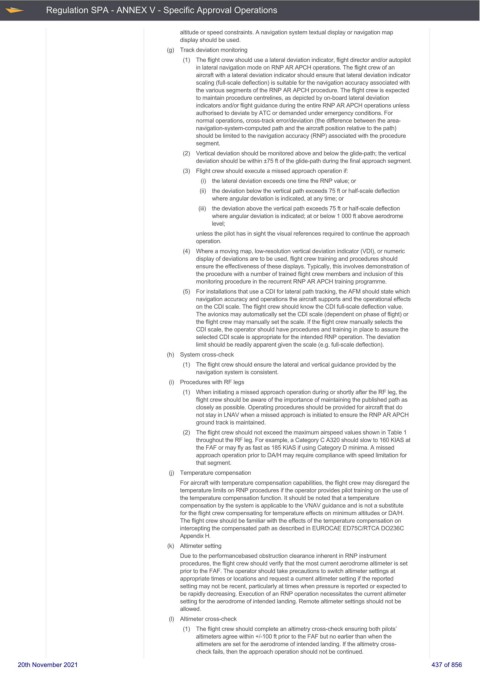Page 437 - UK Air Operations Regulations 201121
P. 437
~
~ Regulation SPA - ANNEX V - Specific Approval Operations Centrik
altitude or speed constraints. A navigation system textual display or navigation map
display should be used.
(g) Track deviation monitoring
(1) The flight crew should use a lateral deviation indicator, flight director and/or autopilot
in lateral navigation mode on RNP AR APCH operations. The flight crew of an
aircraft with a lateral deviation indicator should ensure that lateral deviation indicator
scaling (full-scale deflection) is suitable for the navigation accuracy associated with
the various segments of the RNP AR APCH procedure. The flight crew is expected
to maintain procedure centrelines, as depicted by on-board lateral deviation
indicators and/or flight guidance during the entire RNP AR APCH operations unless
authorised to deviate by ATC or demanded under emergency conditions. For
normal operations, cross-track error/deviation (the difference between the area-
navigation-system-computed path and the aircraft position relative to the path)
should be limited to the navigation accuracy (RNP) associated with the procedure
segment.
(2) Vertical deviation should be monitored above and below the glide-path; the vertical
deviation should be within ±75 ft of the glide-path during the final approach segment.
(3) Flight crew should execute a missed approach operation if:
(i) the lateral deviation exceeds one time the RNP value; or
(ii) the deviation below the vertical path exceeds 75 ft or half-scale deflection
where angular deviation is indicated, at any time; or
(iii) the deviation above the vertical path exceeds 75 ft or half-scale deflection
where angular deviation is indicated; at or below 1 000 ft above aerodrome
level;
unless the pilot has in sight the visual references required to continue the approach
operation.
(4) Where a moving map, low-resolution vertical deviation indicator (VDI), or numeric
display of deviations are to be used, flight crew training and procedures should
ensure the effectiveness of these displays. Typically, this involves demonstration of
the procedure with a number of trained flight crew members and inclusion of this
monitoring procedure in the recurrent RNP AR APCH training programme.
(5) For installations that use a CDI for lateral path tracking, the AFM should state which
navigation accuracy and operations the aircraft supports and the operational effects
on the CDI scale. The flight crew should know the CDI full-scale deflection value.
The avionics may automatically set the CDI scale (dependent on phase of flight) or
the flight crew may manually set the scale. If the flight crew manually selects the
CDI scale, the operator should have procedures and training in place to assure the
selected CDI scale is appropriate for the intended RNP operation. The deviation
limit should be readily apparent given the scale (e.g. full-scale deflection).
(h) System cross-check
(1) The flight crew should ensure the lateral and vertical guidance provided by the
navigation system is consistent.
(i) Procedures with RF legs
(1) When initiating a missed approach operation during or shortly after the RF leg, the
flight crew should be aware of the importance of maintaining the published path as
closely as possible. Operating procedures should be provided for aircraft that do
not stay in LNAV when a missed approach is initiated to ensure the RNP AR APCH
ground track is maintained.
(2) The flight crew should not exceed the maximum airspeed values shown in Table 1
throughout the RF leg. For example, a Category C A320 should slow to 160 KIAS at
the FAF or may fly as fast as 185 KIAS if using Category D minima. A missed
approach operation prior to DA/H may require compliance with speed limitation for
that segment.
(j) Temperature compensation
For aircraft with temperature compensation capabilities, the flight crew may disregard the
temperature limits on RNP procedures if the operator provides pilot training on the use of
the temperature compensation function. It should be noted that a temperature
compensation by the system is applicable to the VNAV guidance and is not a substitute
for the flight crew compensating for temperature effects on minimum altitudes or DA/H.
The flight crew should be familiar with the effects of the temperature compensation on
intercepting the compensated path as described in EUROCAE ED75C/RTCA DO236C
Appendix H.
(k) Altimeter setting
Due to the performancebased obstruction clearance inherent in RNP instrument
procedures, the flight crew should verify that the most current aerodrome altimeter is set
prior to the FAF. The operator should take precautions to switch altimeter settings at
appropriate times or locations and request a current altimeter setting if the reported
setting may not be recent, particularly at times when pressure is reported or expected to
be rapidly decreasing. Execution of an RNP operation necessitates the current altimeter
setting for the aerodrome of intended landing. Remote altimeter settings should not be
allowed.
(l) Altimeter cross-check
(1) The flight crew should complete an altimetry cross-check ensuring both pilots’
altimeters agree within +/-100 ft prior to the FAF but no earlier than when the
altimeters are set for the aerodrome of intended landing. If the altimetry cross-
check fails, then the approach operation should not be continued.
20th November 2021 437 of 856

